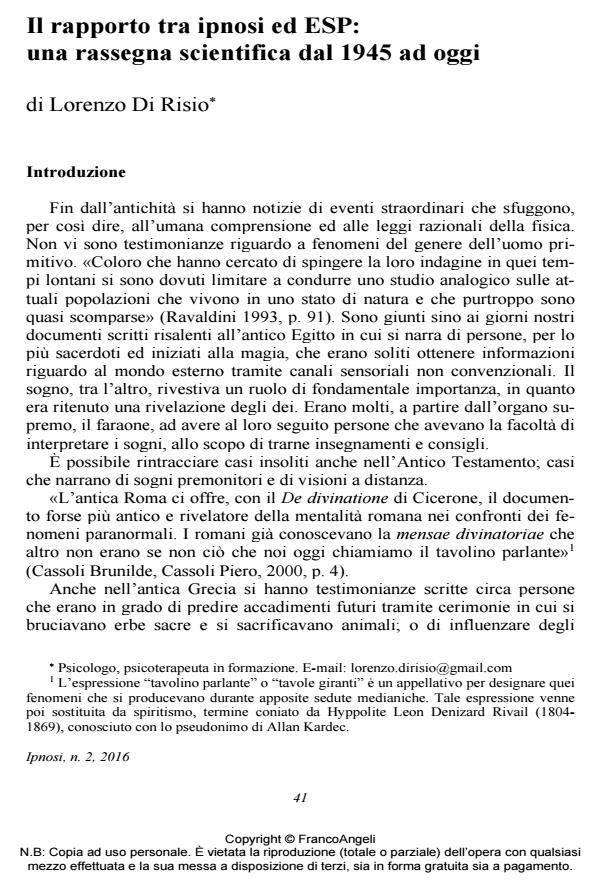Il rapporto tra ipnosi ed ESP: una rassegna scientifica dal 1945 ad oggi
Titolo Rivista IPNOSI
Autori/Curatori Lorenzo Di Risio
Anno di pubblicazione 2016 Fascicolo 2016/2
Lingua Italiano Numero pagine 20 P. 41-60 Dimensione file 251 KB
DOI 10.3280/IPN2016-002003
Il DOI è il codice a barre della proprietà intellettuale: per saperne di più
clicca qui
Qui sotto puoi vedere in anteprima la prima pagina di questo articolo.
Se questo articolo ti interessa, lo puoi acquistare (e scaricare in formato pdf) seguendo le facili indicazioni per acquistare il download credit. Acquista Download Credits per scaricare questo Articolo in formato PDF

FrancoAngeli è membro della Publishers International Linking Association, Inc (PILA)associazione indipendente e non profit per facilitare (attraverso i servizi tecnologici implementati da CrossRef.org) l’accesso degli studiosi ai contenuti digitali nelle pubblicazioni professionali e scientifiche
Il presente lavoro intende analizzare il concetto di ESP, denominata percezione extra-sensoriale (Rhine, 1934) e per verificare, attraverso gli studi condotti nel settore, se possa essere stata rilevata o meno qualche tipo di relazione con l’ipnosi. Verrà posta attenzione sulla nascita di quella che è stata la disciplina che maggiormente si è interessata al rapporto tra l’essere umano e il manifestarsi di determinati fenomeni legati a particolari abilità delle persone: la parapsicologia. Successivamente sarà studiato il concetto di ESP: cosa è e come agisce e come è stata classificata secondo i ricercatori. Il terzo ed il quarto paragrafo entrano più nello specifico analizzando la presunta connessione che intercorre tra l’ipnosi e il manifestarsi di abilità ESP proprio durante la trance ipnotica. Saranno riportati quindi i risultati, in un percorso storico-temporale, delle principali ricerche scientifiche sull’argomento, effettuate in laboratorio sotto strette condizioni di controllo; risultati che, in alcuni casi, sembrerebbero corroborare tale relazione positiva; in altri, viceversa, sembrerebbero smentirla. Infine, i risultati delle ricerche prese in esame saranno poi discussi nell’ultimo paragrafo.
Parole chiave:ESP, percezione extra-sensoriale, ipnosi, parapsicologia
Lorenzo Di Risio, Il rapporto tra ipnosi ed ESP: una rassegna scientifica dal 1945 ad oggi in "IPNOSI" 2/2016, pp 41-60, DOI: 10.3280/IPN2016-002003